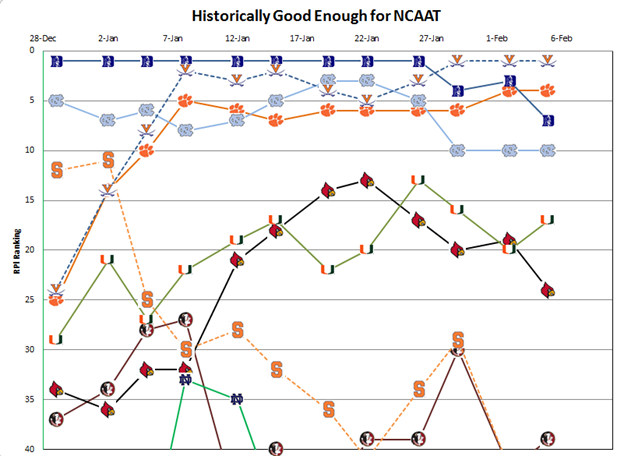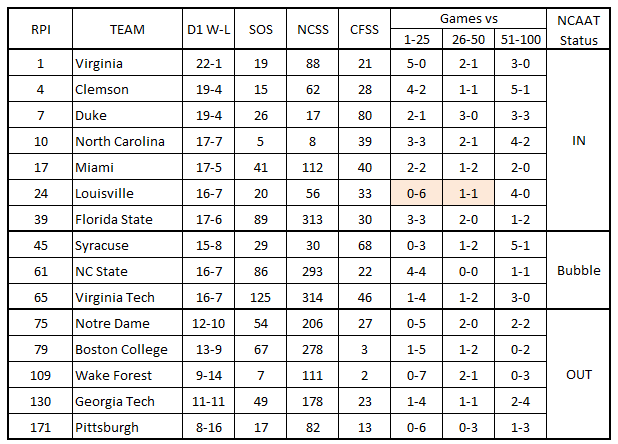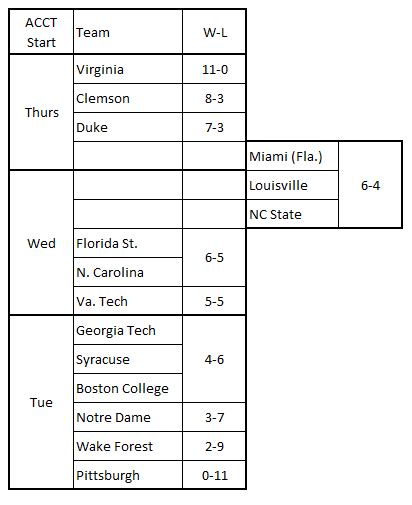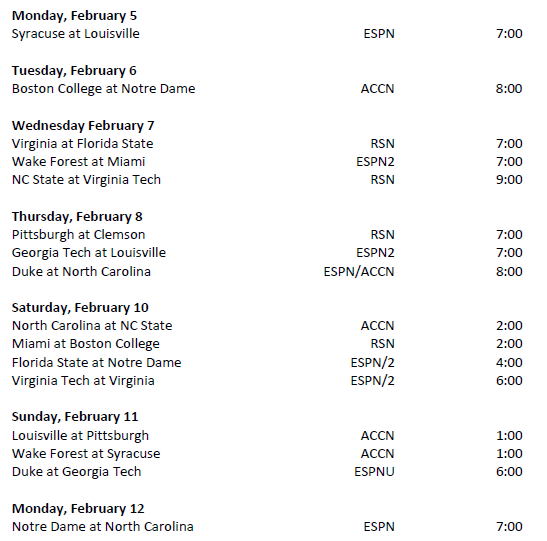Photo from Rob Kinnan, USA TODAY Sports
Before we get to our normal tables, graphs, and discussions, we have some background stuff that needs to be covered:
RABBIT TRAIL #1
On Saturday, I saw someone say that beating ND by a big margin would help State’s RPI.
NO!
NO!!
NO!!!
Obviously it’s been a while since I’ve given my RPI Primer….so here we go again.
The Rating Percentage Index was developed by the NCAA Tournament Selection Committee to help selecting at-large bids and then seeding the NCAAT. I don’t think that we need to discuss the details of the formula, but it has three (and only three) inputs:
- Team’s Winning Percentage (adjusted for road/home/neutral location)
- Opponent’s Winning Percentage (with the results of your game removed)
- Opponent’s Opponent’s Winning Percentage
So do the math for all 351 Division 1 basketball teams and then sort from largest to smallest. Number the sorted RPI’s from 1-351 and you have the RPI Ranking which is usually shortened to just “RPI”. Not only does point spread not matter, who you beat doesn’t affect the RPI calculations (though who you beat is important on Selection Sunday). For instance, If State went 1-1 at home against UNC and WF, their RPI ranking would be the same no matter which of the two teams State beat.
People occasionally like to rant about how horrible the RPI formula is. If the formula were blindly used to select the NCAAT teams, then they would have a point. But the RPI is just part of the selection process and thus not worth the time it takes to bitch about.
RABBIT TRAIL #2
The other big mistake that people make is to bitch about the RPI because of a game-to-game change that they’re not happy with. The key point that some people don’t seem to understand is that what happens to the ranking from one game to the next depends not only on the outcome of the game under discussion, but the results of every team around yours in the rankings.
To illustrate what I’m talking about, here is a graph showing the RPI versus Ranking for the top 80 teams:

What I want you to see is that the “Delta” from one team to the next varies as you go through the standings. So if there is a big gap from one team to the next, then it may take more than one favorable game to overtake the next higher team. On the other hand, there are regions where the total difference between a handful of teams is very small….thus a loss will drop you quickly through the group of teams that are bunched together.
So when we look at the trend graphs, I try to summarize what happened and then the graph shows how much that week’s results helped or hurt. If it doesn’t make sense, then you can rest assured that the unexpected result came because of the gap between teams or what happened to those teams on either side of the team in question.
So with all of that behind us, let’s go to the Trend Graphs
RPI TREND GRAPHS
ESPN’s RPI numbers are gakked up this morning. I’ve seen this before and it may get fixed today, but maybe not. So all of the numbers are from Sunday’s ESPN report, except for BC (from CBS this morning).

UVa had another 2-0 week to remain at #1.
The road loss to St John’s dropped Duke to their lowest point since at least the start of ACC play. Here’s an article if you want to know more details on the Duke loss.
Clemson got a nice boost in their ranking by beating UNC at home. They followed that up with a win at WF for a 2-0 week.
UNC’s graph is rather strange. Neither their loss at Clemson, nor their win at home over Pitt budged their ranking.
Miami also beat Pitt at home, but still dropped a little in the rankings (in direct contrast to UNC). But their RPI ranking bounced back up with a road win over VT.
L’ville had a bad week (0-2) to drop down a little.
SYR and FSU got upset on the road mid-week (GT and WF respectively) and dropped into the Bubble Zone. (Note that State has road trips to Atlanta and Winston-Salem remaining on their schedule.) But FSU recovered with a road win at L’ville to move back to IN.

SYR followed up the loss to GT with an absolute beat down by UVa on Saturday to stay in the Bubble Zone (for now).
State’s results are less-than desired since the home win over ND didn’t make up for the drop it got with no mid-week game.
ND extended their losing streak to seven and has fallen off the Bubble.
VT and BC both had a 1-1 week to bounce around the outer edges of the Bubble (though BC is on the wrong side of the line).
RABBIT TRAIL #3
This is the last rabbit trail (for this week).
Over the last several weeks, State, BC, and ND have had their scheduled break and all three dropped in the rankings during that break. Since this drop occurred in essentially the same region of the Bubble, what conclusions can we draw from this?
If we look at the winning percentage for teams ranked from 50-75, we find that the teams are winning about two games out of three. So if the teams are grouped tightly enough, it’s not surprising that a few teams would move past you when you aren’t playing.
So why does this change matter? Let’s go back to last week’s discussion where I argued that a 4-5 record down the stretch wouldn’t make State a lock for the NCAAT. My argument was based only on logic…sound logic, but no real proof. But if we look at dropping in the rankings without playing, then how much would State drop if they finish the regular season with a losing record over the last half of the conference schedule? Now they still might make the NCAAT, but they certainly wouldn’t be a lock.
This explanation still might not be enough for some of the dimmer members of our fan base, so here’s another piece of data. In 2009, Penn State got left out of the NCAAT with the following resume:
| Win/Loss | 22-11 |
| Conf W/L | 10-8 |
| RPI | 68 |
| SOS | 92 |
| OOC SOS | 304 |
| vs 1-25 | 2-4 |
| vs 26-50 | 4-5 |
This Penn St example should be adequate rebuttal to those who claim that State’s OOC schedule or that their RPI wouldn’t keep State out of the NCAAT because of State’s good wins. If you go back to the entry where we discussed this Penn St decision, you would see that two teams from the Big 10 got at-large bids with worse conference records BUT much better RPI rankings. So once again we see that RPI matters. It’s not the only thing that matters, but it does matter.
This whole discussion brings us back to my formula for making the NIT:
Miserable OOC schedule +
Mediocre conference performance +
Mediocre conference tourney performance =
NIT
So if you want to be a lock before the ACCT starts, you better win enough to move your RPI away from the burst point of the Bubble if you have a terrible OOC schedule…like State does this year.
One last thing….in the past State has moved off of the Bubble and into the NCAAT with big wins in the ACCT. It happened two or three times during the Sendek era (the exact number is up for debate) and once with Gott (when State played in the First Four). I was shocked that State made the NCAAT with TJ Warren, but I certainly didn’t suggest that State should turn down the bid. So the ACCT remains the last chance for the desperate.
Now back to our normal tables and discussion:
RPI SUMMARY TABLE

I was pretty pessimistic last week about Syracuse, but Joe Lunardi laid it out better than I did:
My head says the Orange (15-6, 4-4) [now 4-6] are overachieving and don’t have quite enough to land an NCAA bid. They are 0-5 against the best teams on their schedule to date and must still host Virginia and North Carolina while visiting Louisville, Miami and Duke. A winning ACC record seems too much to ask.
- Note if you really like figuring out where the thin line between the First Four and the NIT are, then you should click the Lunardi link above. He goes through examples of where Syracuse fell just on one side or the other over the last decade.
L’ville still only has one Top 50 win…on the road at FSU. Of course this past week they returned the favor when they lost the return game with FSU. I’m not going to make a big deal out of this today, but it is highly unusual for an ACC team to have only one Top 5o RPI win this late in the season while having a Top 25 RPI. In any event, you can add L’ville to the list of teams with tough finishes to their schedule. They still have games left against UNC, Duke, and UVA along with road trips to Blacksburg and Raleigh.
On Sunday night, State was listed in 67 of 79 brackets on the Bracket Matrix. That might not be worth a whole lot, but it sure is fun to see. But the average seed was 10.64, so it wouldn’t take many losses to disappear real fast.
So far, The Dance Card hasn’t updated their web site yet for this season. With the change in the selection process this year, I don’t know if they are taking a wait and see approach or not. I wish they would update so that we could see if the new system has any real effect on the overall selection process.
ACC STANDINGS

The bottom of the ACC is starting to look really bad…and UVa continues to run away from everyone else.
VT has now lost to both FSU and UM at home. Those aren’t horrible losses by any means, but VT needs wins badly. They still have two games left against Duke, road games against UVA, Duke, and Miami along with Clemson and L’ville at home. As I said the other week, I don’t like their chances.
To the best of my memory, State never got a one-round bye in the 12 team ACC and certainly hasn’t gotten a two-round bye in our current ginormous configuration. They might not get there this year, but you have to admit that it looks nice to be tied for fourth place. Miami and Duke are still tracking for the two easiest ACC schedules, so I don’t think that State can pass them…but that’s why they play the games.
UPCOMING ACC SCHEDULE

Based on the predictive algorithms at Team Rankings and RPI Wizard, this will be State’s toughest week remaining in the regular season. My source (ie friend who actually watches VT BB) says that VT is weak inside and usually gets out rebounded. He also says that their outside shooting runs hot and cold. So we’ll soon see if he knows what he’s talking about or not.
I’m quickly losing hope/interest in the teams currently at the bottom of the conference standings. It seems like those six teams are playing the top half of the conference this week which doesn’t leave many interesting games. Other than the State games, there are only a couple of games that I MIGHT watch:
Monday night might be one of the final nails in SYR’s coffin. I really don’t care that much so I’ll see if there’s anything interesting on and check in on the game from time to time.
FSU has pulled plenty of upsets at home over the years, so I’ll watch to see if they have anything for UVA.
Be prepared for the hype surrounding the first matchup of the Blues this week. The best advice I’ve seen on this game from the perspective of a State fan is to always pull for the visiting team. If the visitors win, then you’ll get a chance to laugh at the crowd shots as the bad news starts to sink in to the home crowd.



